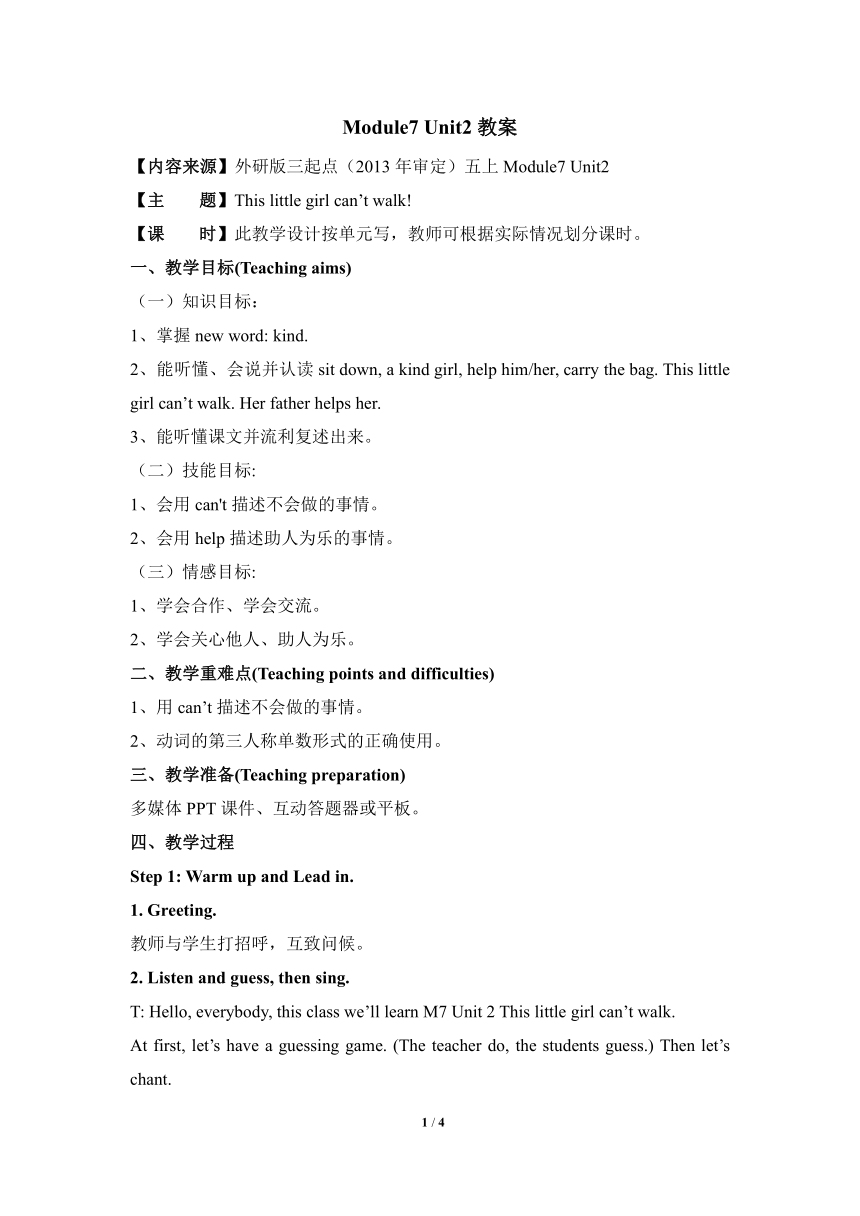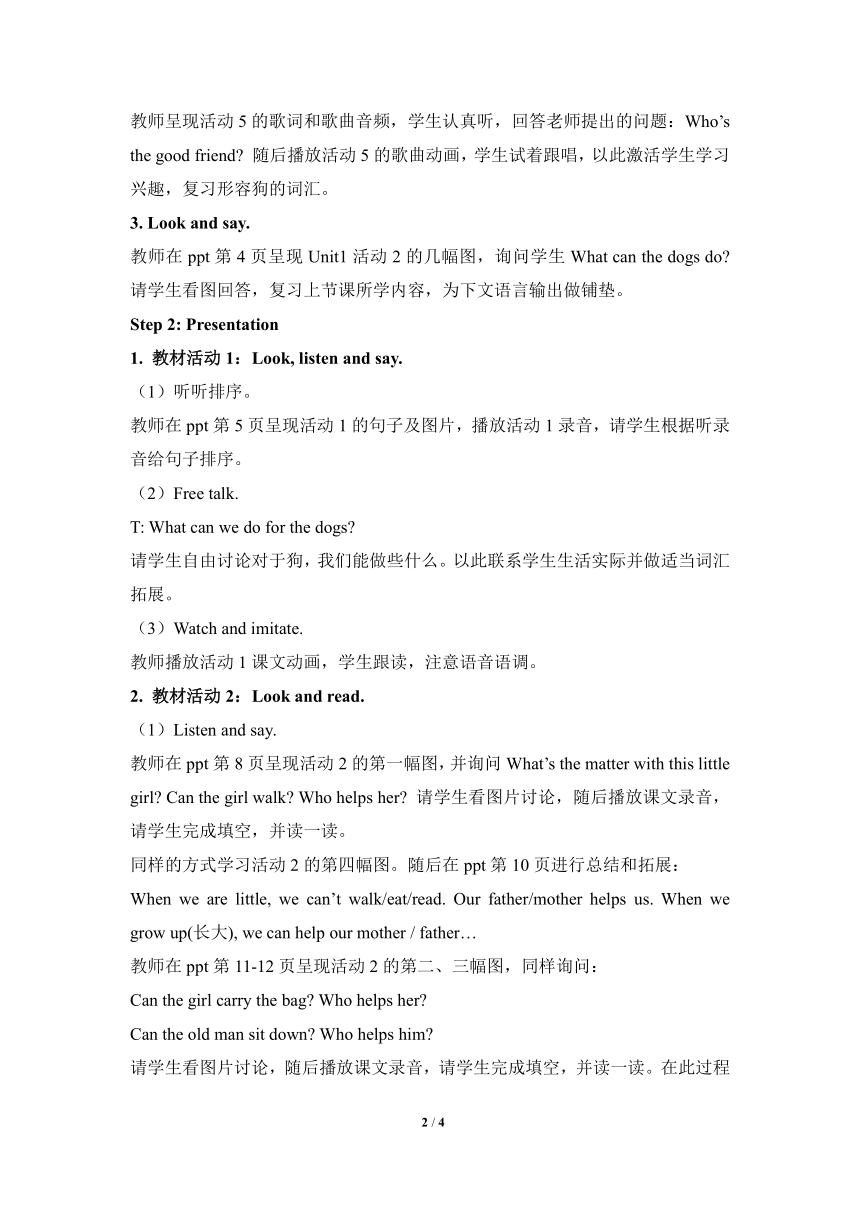Module 7 Unit 2 This little girl can't walk. 教案
文档属性
| 名称 | Module 7 Unit 2 This little girl can't walk. 教案 |  | |
| 格式 | doc | ||
| 文件大小 | 28.0KB | ||
| 资源类型 | 教案 | ||
| 版本资源 | 外研版(三年级起点) | ||
| 科目 | 英语 | ||
| 更新时间 | 2022-08-07 16:00:26 | ||
图片预览


文档简介
Module7 Unit2教案
【内容来源】外研版三起点(2013年审定)五上Module7 Unit2
【主 题】This little girl can’t walk!
【课 时】此教学设计按单元写,教师可根据实际情况划分课时。
一、教学目标(Teaching aims)
(一)知识目标:
1、掌握new word: kind.
2、能听懂、会说并认读sit down, a kind girl, help him/her, carry the bag. This little girl can’t walk. Her father helps her.
3、能听懂课文并流利复述出来。
(二)技能目标:
1、会用can't描述不会做的事情。
2、会用help描述助人为乐的事情。
(三)情感目标:
1、学会合作、学会交流。
2、学会关心他人、助人为乐。
二、教学重难点(Teaching points and difficulties)
1、用can’t描述不会做的事情。
2、动词的第三人称单数形式的正确使用。
三、教学准备(Teaching preparation)
多媒体PPT课件、互动答题器或平板。
四、教学过程
Step 1: Warm up and Lead in.
1. Greeting.
教师与学生打招呼,互致问候。
2. Listen and guess, then sing.
T: Hello, everybody, this class we’ll learn M7 Unit 2 This little girl can’t walk.
At first, let’s have a guessing game. (The teacher do, the students guess.) Then let’s chant.
教师呈现活动5的歌词和歌曲音频,学生认真听,回答老师提出的问题:Who’s the good friend 随后播放活动5的歌曲动画,学生试着跟唱,以此激活学生学习兴趣,复习形容狗的词汇。
3. Look and say.
教师在ppt第4页呈现Unit1活动2的几幅图,询问学生What can the dogs do 请学生看图回答,复习上节课所学内容,为下文语言输出做铺垫。
Step 2: Presentation
1. 教材活动1:Look, listen and say.
(1)听听排序。
教师在ppt第5页呈现活动1的句子及图片,播放活动1录音,请学生根据听录音给句子排序。
(2)Free talk.
T: What can we do for the dogs
请学生自由讨论对于狗,我们能做些什么。以此联系学生生活实际并做适当词汇拓展。
(3)Watch and imitate.
教师播放活动1课文动画,学生跟读,注意语音语调。
2. 教材活动2:Look and read.
(1)Listen and say.
教师在ppt第8页呈现活动2的第一幅图,并询问What’s the matter with this little girl Can the girl walk Who helps her 请学生看图片讨论,随后播放课文录音,请学生完成填空,并读一读。
同样的方式学习活动2的第四幅图。随后在ppt第10页进行总结和拓展:
When we are little, we can’t walk/eat/read. Our father/mother helps us. When we grow up(长大), we can help our mother / father…
教师在ppt第11-12页呈现活动2的第二、三幅图,同样询问:
Can the girl carry the bag Who helps her
Can the old man sit down Who helps him
请学生看图片讨论,随后播放课文录音,请学生完成填空,并读一读。在此过程中教授新词kind。
(2)Watch and imitate.
教师播放活动2课文动画,学生整体跟读,模仿语音语调。
(3)Show time.
请学生选择一幅图,小组合作进行描述,随后到讲台前展示。此活动目的在于让学生能运用核心句型描述图片。
Step 3: Practice
1. Play a game.
Who is the lucky dog幸运儿
请学生选择一个号码,根据选中号码对应的内容完成任务,并获取相应得分。
以此游戏的方式完成教材活动3的练习。通过课件的设计,给学生创设一个竞赛的氛围,增强游戏的趣味性,锻炼了学生的口语能力。
2. Ask and answer, then remember and say.
根据图片,通过给出的例子,模仿进行表达。
3. Do and say
How many animals do you know What can/can’t they do
教师呈现表格调查,四人小组进行调查讨论。根据给出的表格,用can/can’t进行描述。如:Tiger can’t fly. 完成表格。
4. Listen and repeat.
(1)教师播放听力,学生感受字母发音,总结规律,注意爆破音。学生跟读。
(2)Chant with me. 播放字母韵律说唱,学生试着跟唱。
(3)进行分类练习。
Step 4: Consolidation
课堂练习:打开M7U2课堂基础练,学生借助答题器或平板电脑作答,即学即练,检测当堂学习情况。
Step 5: Summary
T: What have we learnt today Summarize the important language points.
1. 小结can的用法口诀
我是情态动词can,若表能力我能担。
不管主语怎么变,can的模样都不变。
动词原形站后边,一般疑问句can在前。
否定句can后需把not添,学好can并不难。
2. 情态动词的基本句型
肯定句型为:主语+can+动词原形+其它。
They can play basketball.他们能打篮球。
否定句型为:主语+can not(can’t)+动词原形+其它。其中can’t是can not的缩略式
I can’t ride a bike.我不会骑自行车。
一般疑问句句型为:Can+主语+动词原形+其它。
肯定答语:Yes, 主语+can.
否定答语:No, 主语+can’t.
3. 本课句子小结。
PPT树形图帮助梳理和巩固本课所学。
4. 拓展
Today, we have many difficulties in our life. For example: I like football.
But I can’t play football well. My father helps me. Talk about them in your group and then make a presentation.
Discuss in groups and try to say.
利用课件的播放,将所学的知识与日常生活相结合,达到学以致用的目的。
Step 6: Homework
1. Look and read.
2. Try to write it down if you can.
板书设计
Module 7 Unit 2 This little girl can’t walk.
swim 游泳 walk 走路
sit down坐下 carry 携带
主语+can not(can’t)+动词原形+其它
I can’t swim in the sea.
2 / 4
【内容来源】外研版三起点(2013年审定)五上Module7 Unit2
【主 题】This little girl can’t walk!
【课 时】此教学设计按单元写,教师可根据实际情况划分课时。
一、教学目标(Teaching aims)
(一)知识目标:
1、掌握new word: kind.
2、能听懂、会说并认读sit down, a kind girl, help him/her, carry the bag. This little girl can’t walk. Her father helps her.
3、能听懂课文并流利复述出来。
(二)技能目标:
1、会用can't描述不会做的事情。
2、会用help描述助人为乐的事情。
(三)情感目标:
1、学会合作、学会交流。
2、学会关心他人、助人为乐。
二、教学重难点(Teaching points and difficulties)
1、用can’t描述不会做的事情。
2、动词的第三人称单数形式的正确使用。
三、教学准备(Teaching preparation)
多媒体PPT课件、互动答题器或平板。
四、教学过程
Step 1: Warm up and Lead in.
1. Greeting.
教师与学生打招呼,互致问候。
2. Listen and guess, then sing.
T: Hello, everybody, this class we’ll learn M7 Unit 2 This little girl can’t walk.
At first, let’s have a guessing game. (The teacher do, the students guess.) Then let’s chant.
教师呈现活动5的歌词和歌曲音频,学生认真听,回答老师提出的问题:Who’s the good friend 随后播放活动5的歌曲动画,学生试着跟唱,以此激活学生学习兴趣,复习形容狗的词汇。
3. Look and say.
教师在ppt第4页呈现Unit1活动2的几幅图,询问学生What can the dogs do 请学生看图回答,复习上节课所学内容,为下文语言输出做铺垫。
Step 2: Presentation
1. 教材活动1:Look, listen and say.
(1)听听排序。
教师在ppt第5页呈现活动1的句子及图片,播放活动1录音,请学生根据听录音给句子排序。
(2)Free talk.
T: What can we do for the dogs
请学生自由讨论对于狗,我们能做些什么。以此联系学生生活实际并做适当词汇拓展。
(3)Watch and imitate.
教师播放活动1课文动画,学生跟读,注意语音语调。
2. 教材活动2:Look and read.
(1)Listen and say.
教师在ppt第8页呈现活动2的第一幅图,并询问What’s the matter with this little girl Can the girl walk Who helps her 请学生看图片讨论,随后播放课文录音,请学生完成填空,并读一读。
同样的方式学习活动2的第四幅图。随后在ppt第10页进行总结和拓展:
When we are little, we can’t walk/eat/read. Our father/mother helps us. When we grow up(长大), we can help our mother / father…
教师在ppt第11-12页呈现活动2的第二、三幅图,同样询问:
Can the girl carry the bag Who helps her
Can the old man sit down Who helps him
请学生看图片讨论,随后播放课文录音,请学生完成填空,并读一读。在此过程中教授新词kind。
(2)Watch and imitate.
教师播放活动2课文动画,学生整体跟读,模仿语音语调。
(3)Show time.
请学生选择一幅图,小组合作进行描述,随后到讲台前展示。此活动目的在于让学生能运用核心句型描述图片。
Step 3: Practice
1. Play a game.
Who is the lucky dog幸运儿
请学生选择一个号码,根据选中号码对应的内容完成任务,并获取相应得分。
以此游戏的方式完成教材活动3的练习。通过课件的设计,给学生创设一个竞赛的氛围,增强游戏的趣味性,锻炼了学生的口语能力。
2. Ask and answer, then remember and say.
根据图片,通过给出的例子,模仿进行表达。
3. Do and say
How many animals do you know What can/can’t they do
教师呈现表格调查,四人小组进行调查讨论。根据给出的表格,用can/can’t进行描述。如:Tiger can’t fly. 完成表格。
4. Listen and repeat.
(1)教师播放听力,学生感受字母发音,总结规律,注意爆破音。学生跟读。
(2)Chant with me. 播放字母韵律说唱,学生试着跟唱。
(3)进行分类练习。
Step 4: Consolidation
课堂练习:打开M7U2课堂基础练,学生借助答题器或平板电脑作答,即学即练,检测当堂学习情况。
Step 5: Summary
T: What have we learnt today Summarize the important language points.
1. 小结can的用法口诀
我是情态动词can,若表能力我能担。
不管主语怎么变,can的模样都不变。
动词原形站后边,一般疑问句can在前。
否定句can后需把not添,学好can并不难。
2. 情态动词的基本句型
肯定句型为:主语+can+动词原形+其它。
They can play basketball.他们能打篮球。
否定句型为:主语+can not(can’t)+动词原形+其它。其中can’t是can not的缩略式
I can’t ride a bike.我不会骑自行车。
一般疑问句句型为:Can+主语+动词原形+其它。
肯定答语:Yes, 主语+can.
否定答语:No, 主语+can’t.
3. 本课句子小结。
PPT树形图帮助梳理和巩固本课所学。
4. 拓展
Today, we have many difficulties in our life. For example: I like football.
But I can’t play football well. My father helps me. Talk about them in your group and then make a presentation.
Discuss in groups and try to say.
利用课件的播放,将所学的知识与日常生活相结合,达到学以致用的目的。
Step 6: Homework
1. Look and read.
2. Try to write it down if you can.
板书设计
Module 7 Unit 2 This little girl can’t walk.
swim 游泳 walk 走路
sit down坐下 carry 携带
主语+can not(can’t)+动词原形+其它
I can’t swim in the sea.
2 / 4
同课章节目录
- Module 1
- Unit 1 Did you come back yesterday?
- Unit 2 We bought ice creams.
- Module 2
- Unit 1 What did you buy?
- Unit 2 How much cheese did you buy?
- Module 3
- Unit 1 Where did you go?
- Unit 2 Daming took a photo of his father.
- Module 4
- Unit 1 Mum bought a new T-shirt for me.
- Unit 2 What's the matter with Daming?
- Module 5
- Unit 1 There are only nineteen crayons
- Unit 2 There are forty.
- Module 6
- Unit 1 You can play football well.
- Unit 2 He ran very fast.
- Module 7
- Unit 1 He can't see.
- Unit 2 This little girl can't walk.
- Module 8
- Unit 1 What time does your school start?
- Unit 2 Yesterday I went to Sam and Amy's school.
- Module 9
- Unit 1 Are you feeling bored?
- Unit 2 I feel happy.
- Review Module
- Unit 1
- Unit 2
- Module 10
- Unit 1 He was in the kitchen.
- Unit 2 Don't shout, please!
- 旧版资料
- Module 1 London
- Module 2 Shopping
- Module 3 At the Weekend
- Module 4 Possession
- Module 5 In Class
- Module 6 Self-assessment
- Module 7 Community
- Module 8 School
- Module 9 Feelings
- Module 10 Manners
- Review Module
